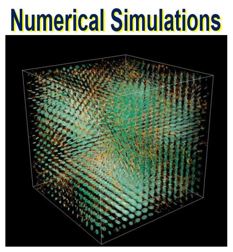Scientists have used equations by Einstein to simulate the expansion of the Universe – they developed a new code of numerical simulations that offers us a glimpse of the complex process of the formation of all the structures that exist out there in the Universe.
A team of physicists from the University of Geneva (UNIGE) in Switzerland explained in the academic journal Nature Physics (citation below) that based on Einstein’s equations, they were able to integrate the rotation of space-time into their calculations and work out the amplitude of gravitational waves.
The existence of gravitational waves was first confirmed this year on 12th February. Gravitational waves are ripples (distortions) in the fabric of space-time, caused by some of the most energetic and violent processes in the Universe. Albert Einstein predicted their existence one hundred years ago in his General Theory of Relativity.
 Image shows the gravitational waves generated during the formation of structures. They (distribution of masses) are shown as bright dots – gravitational waves by ellipses. The size of the ellipse is proportional to the amplitude of the wave and its orientation represents its polarization. (Image: UNIGE. Credit: Ruth Durrer)
Image shows the gravitational waves generated during the formation of structures. They (distribution of masses) are shown as bright dots – gravitational waves by ellipses. The size of the ellipse is proportional to the amplitude of the wave and its orientation represents its polarization. (Image: UNIGE. Credit: Ruth Durrer)
Using Newtonian gravitation
Scientists have always studied the formation of large-scale structures in the Universe based on numerical simulations of Newtonian gravitation. These codes hypothesize that space itself does not alter – it is static – while time goes on.
The simulations that it allows are extremely precise if all matter in the Universe moves slowly – about 300 kilometres per second.
When matter particles move ultra-fast, however, the calculations using this code become much less precise. Furthermore, they do not describe the fluctuations of dark energy.
Dark energy makes up about 70% of all energy in the Universe, while the remaining 30% is dark and ordinary matter. Dark energy is responsible for the accelerated expansion of the Universe.
Therefore, it became necessary to find a new way to simulate how cosmological structures form and allow the study of these two phenomena.
 Professor Ruth Durrer and colleagues plan to make their gevolution code public. (Image: UNIGE)
Professor Ruth Durrer and colleagues plan to make their gevolution code public. (Image: UNIGE)
Scientists applied the theory of general relativity
Professor Ruth Durrer, who works at UNIGE’s Department of Theoretical Physics, and colleagues created Gevolution, a code based on Einstein’s Theory of General Relativity.
Indeed, general relativity considers space-time as being dynamical, i.e. space and time are constantly changing, unlike Newton’s theory in which space is static.
In this study, the team’s goal was to predict the amplitude and impact of gravitational waves and the rotation of space-time (frame-dragging) induced by the formation of cosmological structures.
To do this, UNIGE scientists analyzed a cubic portion in space, consisting of 60 billion zones, each one containing a particle (i.e. a portion of a galaxy), in order to study how they move with respect to their neighbours.
Thanks to the LATfield2 library, which was developed by UNIGE’s David Daverio, which solves the non-linear partial differential equations, and the Supercomputer from the Swiss Supercomputer Centre in Lugano, the physicists were able to study the motion of particles and calculate the measurement of distances and time between two galaxies in the Universe (the metric) using Einstein’s equations.
These calculations’ resulting spectra allow us to quantify the difference between the Gevolution results and those coming from Newtonian codes. This meant scientists could now measure the effect of frame-dragging and gravitation waves introduced by the formation of structures in the Universe.
Using Gevolution to predict gravitational waves and frame-dragging
Before the creation of the Gevolution code, frame-dragging and gravitational waves had never been included in simulations. This opens up the way for the comparison of simulation results of the Universe’s evolution with observations.
With their code, UNIGE physicists will be able to test the Theory of General Relativity on much greater scales than currently possible.
Prof. Durrer and colleagues say they will make their Gevolution code public in order to open research to a maximum in this field.
The authors hope we will soon have a better understanding of dark energy.
Citation: “General relativity and cosmic structure formation,” Julian Adamek, David Daverio, Ruth Durrer & Martin Kunz. Nature Physics. 7 March 2016. DOI: 10.1038/nphys3673.
Video – What is Gravity? Newton vs. Einstein

